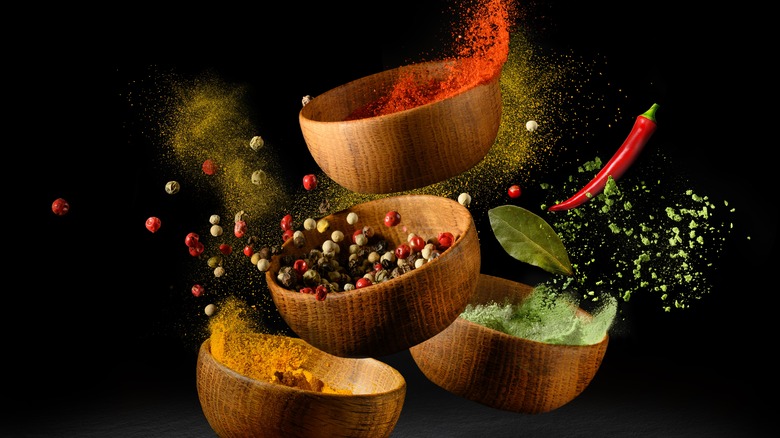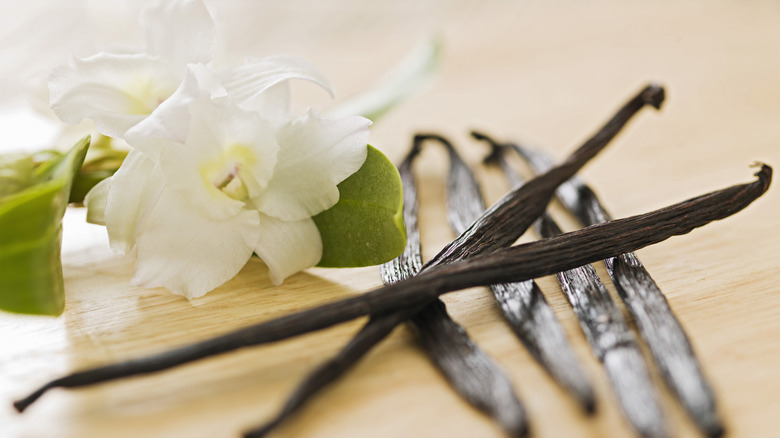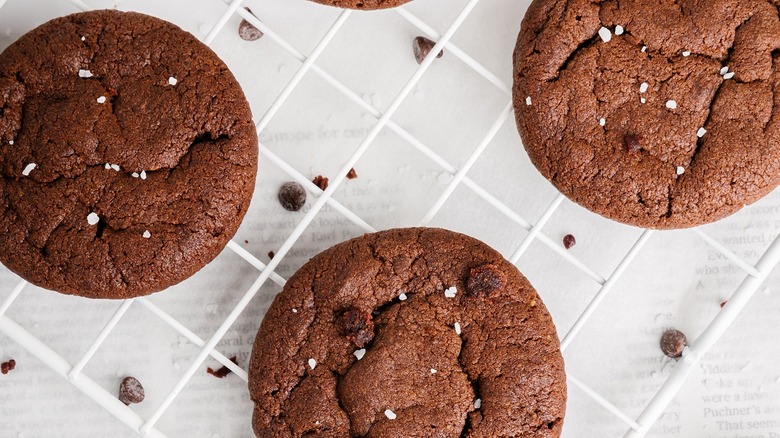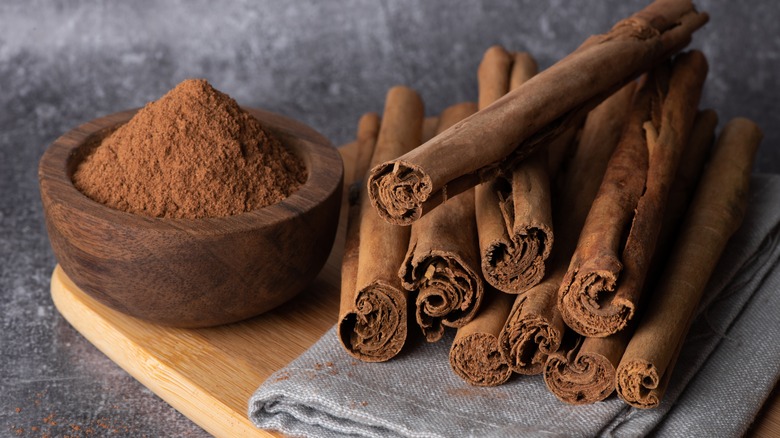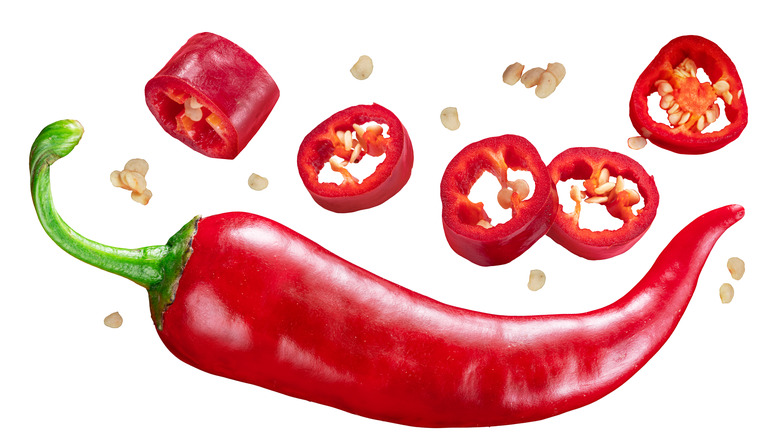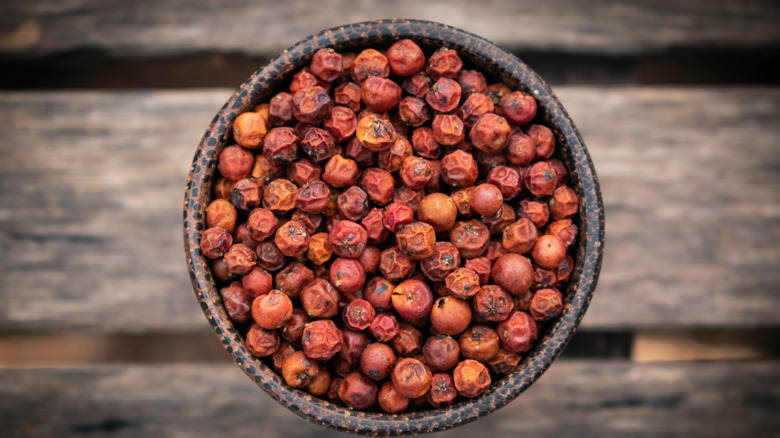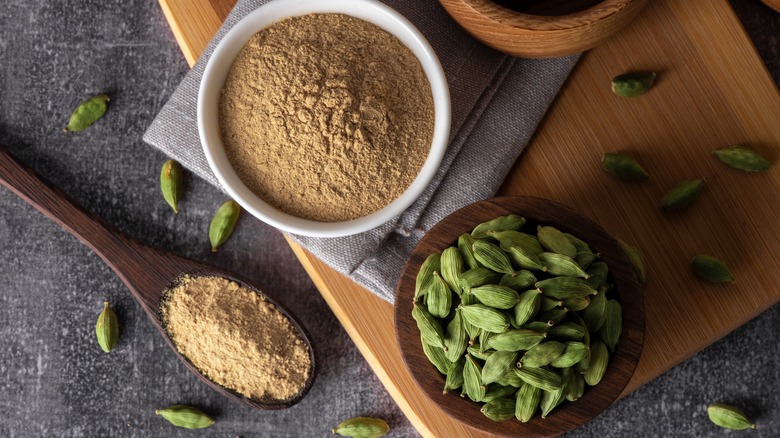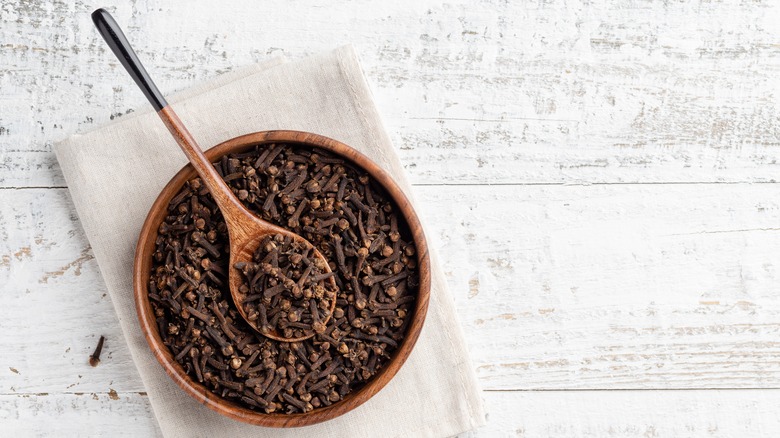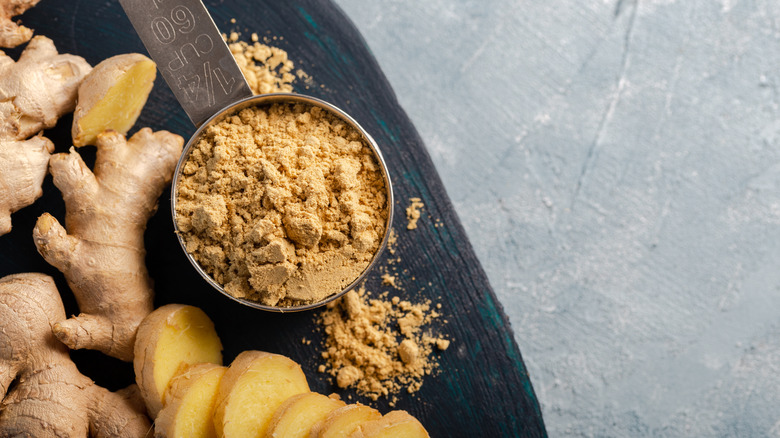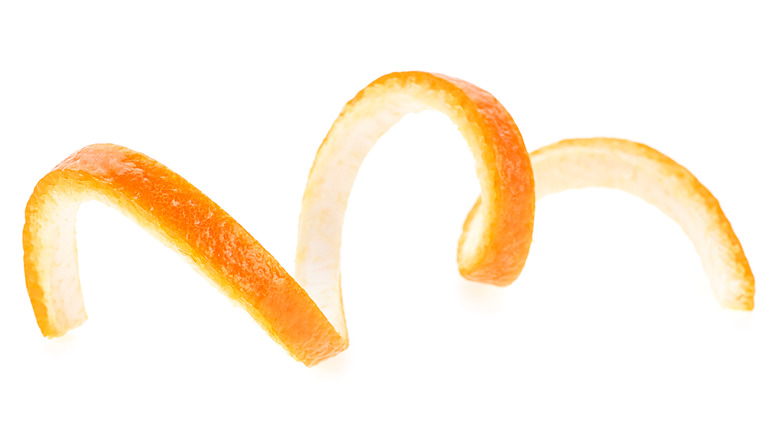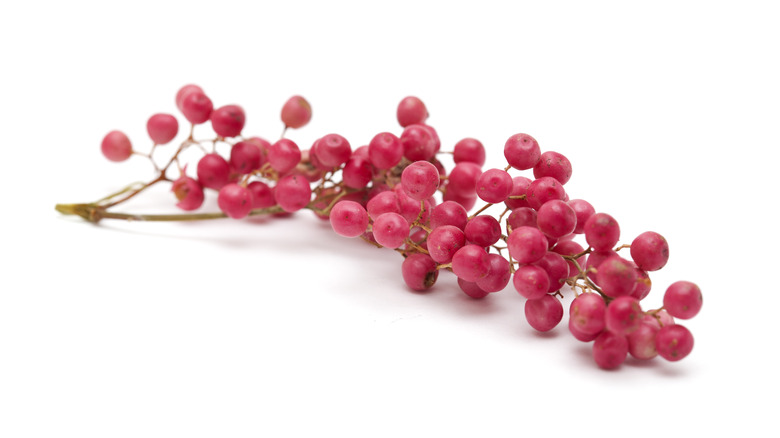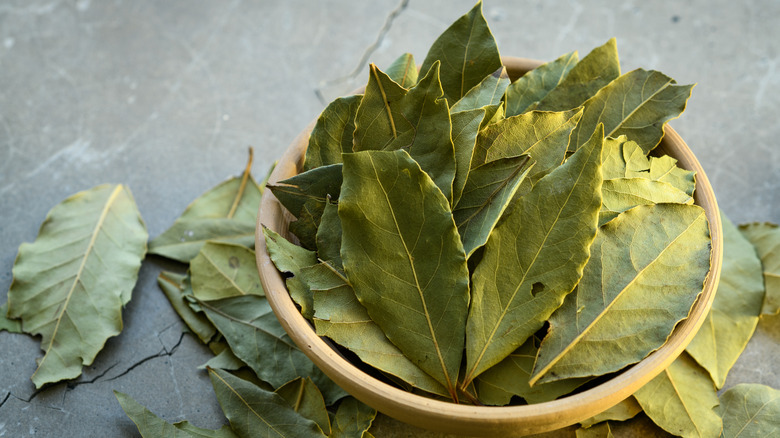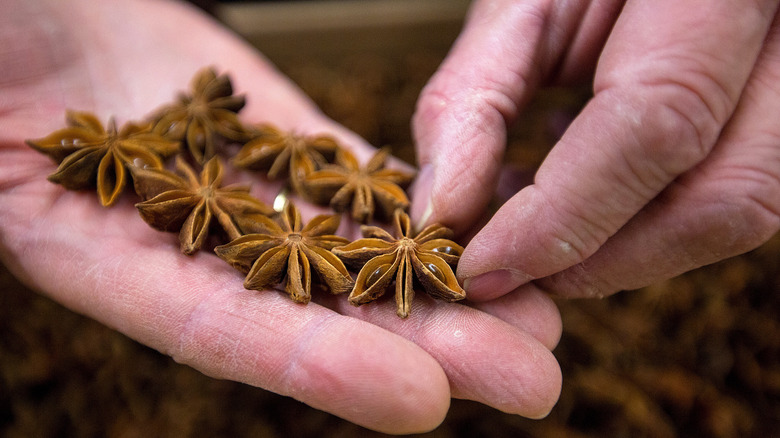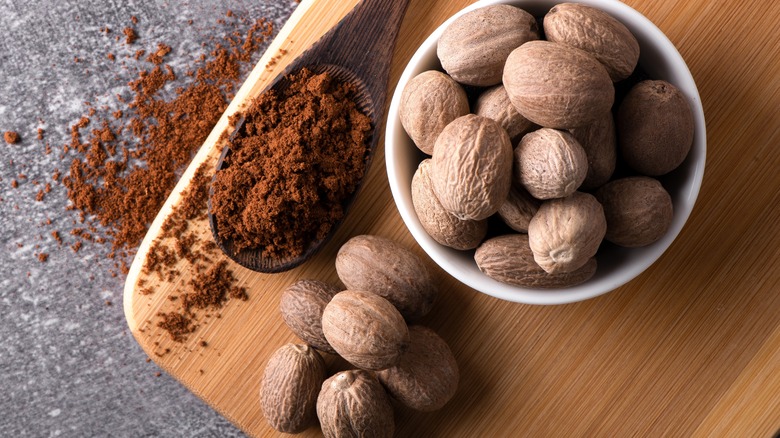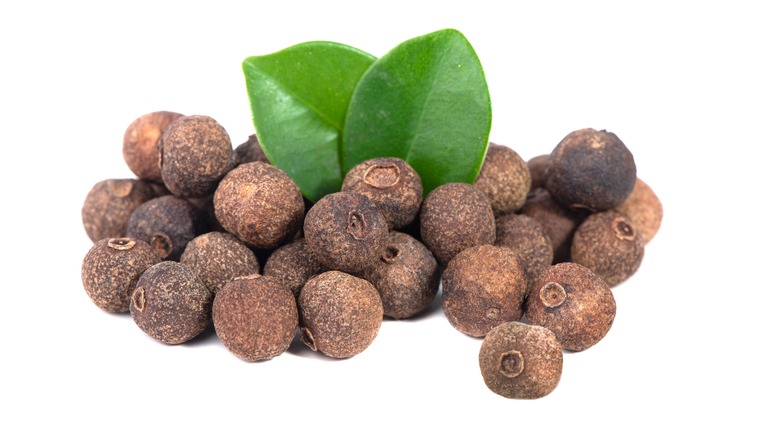14 Spices You Should Be Pairing With Chocolate
It's no secret that spices can enhance food. Humans have been trading spices for over 3,500 years to add flavor to food (via Penn State Extension). Our pantries are stocked full of essential spices from around the world. You might turn to your spice cabinet in your everyday cooking, but have you taken advantage of how spices can complement this one particular ingredient? Made from cacao beans, indigenous to Central and South America, civilizations have enjoyed chocolate for at least 2,000 years (via Smithsonian Magazine). Imagine this beloved food being improved even more with the addition of spices.
We spoke to some industry experts to find out what spices you should be pairing with chocolate. John Beaver is a co-founder and co-owner of Oaktown Spice Shop, which has stores in the San Fransisco Bay Area. Beaver recognizes how many spices go well with chocolate, stating, "Sometimes the spice complements the inherent cocoa flavors, and some add a nice contrast."
Ethan Frisch is a co-founder and co-CEO of Burlap & Barrel, an online spice company. Frisch loves the combination of tart, fruity flavors with chocolate, and he recommends combining spices with high-quality chocolate with "its own particular flavor profile."
Finally, Alex Wilkens is the VP of Product at The Spice House, an online spice retailer with physical locations in Illinois and Wisconsin. Wilkens most appreciates time-tested recipes like spiced ganache in truffles, noting, "When it comes to chocolate, simple and classic always wins me over."
Vanilla
If you think chocolate and vanilla are polar opposites, you are not alone. From childhood, we are made to feel we have to pick one over the other. You are either team chocolate or vanilla — you can't have both. Well, that might not be true.
As it turns out, this dichotomy is unnecessary. John Beaver states that vanilla is the most popular pairing for chocolate and disputes that they are opponents. He attests, "They share so much and complement each other well." Agreeing with this sentiment, Sweetish Hill claims that vanilla enhances chocolate's flavors by balancing bitterness and sweetness.
However, Sweetish Hill warns against adding vanilla extract straight into melted chocolate, as it will immediately seize, meaning it will clump and harden. You'll need to add vanilla to a chocolate mixture, such as brownie batter. For the best flavor experience, make sure you use pure vanilla extract, which should have an alcohol content of at least 35% and contain three simple ingredients: vanilla, water, and alcohol.
Salt
Salt provides many benefits in cooking, so it should be unsurprising that it makes a good pairing for chocolate. According to Beaver, "Salt provides a contrast to the sweet but also helps you taste the flavors in the chocolate."
These spice experts agree that texture is key when using salt with chocolate. Beaver prefers a natural flaky sea salt like this Humboldt flake sea salt. Both Frisch and Wilkens comment that salt can provide a nice crunch to juxtapose chocolate's creamy texture. Frisch appreciates a light, flaky salt like this Salina crystal salt to get "that interesting textural contrast."
When you want a more dramatic experience, Wilkens recommends trying Hawaiian Kiawe Smoked Salt as a garnish for chocolate desserts. He explains, "Expertly smoked with native island mesquite wood, this coarse sea salt is super smooth and roasty, a perfect finish for dark chocolate truffles, flourless chocolate cakes, or scoops of chocolate ice cream."
Humans are also biologically wired to crave this salty-sweet flavor combination, as it can trigger our brains to release dopamine, reducing our response to stress (via Vox Creative). Furthermore, scientific research has shown that the extra sugar sensors on our tongues only respond to sugar when salt is also present (via Proceedings of the National Academy of Sciences). If you want to test this phenomenon yourself, try this recipe for salted chocolate cookies, which combines rich Valrhona chocolate with fleur de sel.
Cinnamon
Did you know there are different types of cinnamon? Cinnamomum cassia, also known as Chinese cinnamon, comes from the bark of a tree native to China (via The Woks of Life). The more readily available type in the United States, cassia cinnamon, tends to have a stronger, spicier flavor with a more pronounced sweetness. The Spice House explains that within cassia cinnamon, you'll find variations, including Saigon (from Vietnam) or Kortintje (from Indonesia).
However, they add that Cinnamomum verum (from Sri Lanka) is considered the "true" cinnamon. Also known as Ceylon cinnamon, this spice, with its floral and citrus aromas, is often preferred over cassia, but is it the best one to use with chocolate?
Beaver and Wilkens recommend Ceylon. Beaver attests that Sri Lankan cinnamon "has the most diversity of flavors, but it is also the mildest." It will work well with chocolate in savory applications like a mole as well as sweets. Wilkens agrees that Ceylon cinnamon allows the chocolate to shine the most, finding that cassia "are big and bold flavored cinnamons that tend to overpower the chocolate flavor."
In a contrasting opinion, Frisch goes for Royal Cinnamon, their Vietnamese version, since its strong flavor can hold up against the chocolate better. He states, "Other varieties of cinnamon will be less sweet or have a more subtle flavor in general, which will make them trickier to pair with chocolate." Since this is a matter of personal taste, you'll have to decide which you like better.
Chili peppers
A little heat with chocolate is a great way to wake up your taste buds. Chili peppers will upgrade your hot chocolate, and chocolate is a staple ingredient in the chile-forward mole sauce. However, the chile-chocolate combo is not just for mole. A little cayenne pepper will bring out the richness in chocolate chip cookies.
According to Wilkens, "Chocolate and chiles are a natural match because they contain so many common and/or complementary flavors. Chocolate's nutty, floral, citrusy, earthy profile can be balanced or amplified by adding a particular chile's fruity, smokey, acidic, or peppery flavors." He suggests adding Urfa chile flakes (from Turkey) to brownies and chocolate chip cookies.
Frisch also points out that chiles and chocolate are native to Mexico and Central America, where they have been consumed together and separately for thousands of years. Think Mexican hot chocolate. He adds, "I would recommend an heirloom Mexican or Central American chili for this pairing, something with sweetness as well as heat, like pasilla, cobanero or smoked chipotle."
Beaver also appreciates this pairing, noting, "The fat of the chocolate tames the heat and the sweet, fruity flavor of the chile provides a tasty complement." He likes ancho and pasilla chiles, as they are the most cocoa-like in flavor, but he explains that chipotles have the added benefit of smokiness, providing an extra layer of flavor. Beaver also proclaims that pepper flakes (not powdered spice) will provide better texture and a burst of flavor.
Kampot red peppercorns
Kampot might sound like an unfamiliar name, but the spice should not be. Kampot red peppercorns are black peppercorns that are allowed to ripen on the vine fully, Beaver explains, which results in a more developed flavor.
According to Wilken, this peppercorn gets its name because it's only grown in the Kampot region of Cambodia. Wilkens thinks Kampot red peppercorn is a "truly special" spice. By fully ripening the peppercorns, he states, "This translates into a finished product that is unusually fruity, floral, and brings less peppery heat than traditional black peppercorns. Freshly cracked Kampot Red Peppercorns are a perfect choice to top off a chocolatey dessert."
On a similar note, Frisch recommends their purple peppercorns. Grown on a small farm in Vietnam, purple peppercorns are also fully ripened on the vine, "which gives them a sweeter, fruitier and more complex flavor that pairs well with the sweetness and fruitiness of chocolate."
Cardamom
Popular in Middle Eastern and Asian cuisines, cardamom is a powdered spice made from seed pods, but you can also buy green and black cardamom pods. Green cardamom (Elleteria cardomomum) is native to India and commonly used in their cuisine (via The Woks of Life). Frisch describes cardamom as having a "gingery, citrusy flavor" that pairs well with both dark and milk chocolate. Beaver also notes, "Cardamom has similar cooling properties to something like mint, so it can round out chocolate, and its sweet and fragrant qualities stand up nicely to chocolate's bitterness." This effect can be experienced in desserts such as this chocolate Turkish coffee cake, which enhances the chocolate's flavor with ground cardamom.
Not considered "true" cardamom, black cardamom (Amomum subulatum) originates from the Eastern Himalayas and is commonly cultivated in Nepal and China. The Woks of Life doesn't recommend using it for sweets, but when it comes to chocolate, our spice experts would beg to differ.
Beaver thinks black cardamom might be too sharp for dark chocolate, but he predicts it would work well with milk or white chocolate, given its citrusy and smoky flavor. This traditionally smoked spice may not be the most obvious choice for dessert, but Frisch used black cardamom in a smoky dark chocolate ice cream when working as a pastry chef. However, when cooking with cardamom, remember that this spice can easily overpower other flavors when you use too much.
Cloves
This next spice is another one with which you will want to practice restraint. If you have ever looked at whole cloves and wondered what gives them their odd shape, it is because they are the dried flower buds of the clove tree. This Indonesian spice is known for having an intense taste. Whether using whole cloves or powdered spice, you have to be careful not to overwhelm the other flavors in your dish.
Beaver recommends using ground cloves "in moderation" with chocolate, as too much will leave a noxious taste in your mouth. Frisch also suggests only using ground cloves in small quantities. He states, "Cloves have a sweet, rich flavor, but using too much can numb your mouth and overpower the flavors of the chocolate itself."
James Beard Award-winning food writer David Leite combines the flavors of cloves, cinnamon, and pistachios in a chocolate cookie. He calls for just ¼ teaspoon of ground cloves and ½ teaspoon of ground cinnamon in his chocolate cookie recipe, yielding three dozen cookies.
Ginger
Ginger is a spice that took root over 4,000 years ago. You've seen the earthy knobs in the produce section at the grocery store, and you probably have a container of powdered spice in your pantry. Some people find ginger too spicy, but it can be a true palate pleaser (or cleanser between bites of sushi).
Despite popular belief, ginger is not actually a tuber. University of Madison-Wisconsin's Division of Horticulture explains that ginger is classified as a rhizome. It may be called ginger root, but this plant is a series of underground stems that grows horizontally, giving it the characteristic lumpy shape.
One key tip is not to peel fresh ginger and add it to chocolate. Beaver notes that it would be too sour. However, he thinks ground ginger would add "a nice subtle heat and citrus notes." Beaver does warn, however, that your chocolate concoctions will taste spicier the more ginger you add. Frisch agrees that a little goes a long way. He states, "Ginger and chocolate is a great combo, between the fruitiness and spiciness of the ginger that accentuates and elevate the flavors of the chocolate."
Orange peel
Despite some health benefits, orange peel can upset your stomach when eaten in large quantities. Like other citrus peel, it is bitter and generally not too pleasant to taste unaltered. So why does dried orange peel tastes so good in chocolate desserts?
Beaver describes chocolate and orange peel as an "age-old flavor pairing," but even he is not exactly sure how this combo works so well. He attests, "Orange peel in desserts seems very wintery, maybe Christmasy. Its bitterness somehow doesn't conflict or fight with the chocolate's bitterness — it compliments well. It's also orange flavor without the orange's sourness. Cocoa is already sour enough." The trick to reducing bitterness in dried orange peels lies in removing the white pith from the rind before the peels are dried (via This Healthy Table).
Wilkens also enjoys a good orange and chocolate dessert. Wilkens professes, "Fresh or dried orange peel can more easily be incorporated into a chocolatey recipe by steeping them into a cream component before mixing with the chocolate. Think ganache, panna cotta, ice cream, whipped cream, etc."
Pink peppercorns
It wouldn't be a food list without a couple of confusing misnomers. We've already learned that ginger root is not a root, but you also might be surprised to learn that pink peppercorns are not peppercorns.
Wilkens explains that pink peppercorns are actually dried berries from a tree native to Peru, botanically related to sumac and cashews. Describing their flavor profile, Wilken states, "The flavor of these delicate berries is fruit forward, then floral, and finishing with zesty herbal flavors with very little pepper heat." He likes to combine pink peppercorns and white chocolate not only for the color contrast but because it adds "unique flavors" to creamy white chocolate that primarily just tastes sweet.
Beaver does note that pink peppercorns have a slightly peppery flavor, but he characterizes it as "a sweet floral flavor and none of the peppery bite." Pink peppercorns are a good choice when you want a striking presentation but also a textural experience in your chocolate confections. According to Beaver, one appeal of pairing pink peppercorns with chocolate is that its delicate bite won't leave you with a chipped tooth.
Bay leaf
Is there an herb more misunderstood than bay leaves? No one has pinpointed exactly what this herb does to our food, but we cook with bay leaves because it's got a certain je ne sais quois that provides noticeable but indescribable flavor benefits.
We don't recommend you go chomp down on this herb. Fresh or dried, you need to steep bay leaves in a hot liquid or simmer them in a sauce to extract the flavor. On that matter, Wilkens notes, "Bay leaves are underrated when it comes to introducing herbal flavors into a dish. High-quality Turkish bay leaves are very fragrant with notes of pine, clove, menthol, and citrus, and can be steeped into heavy cream for added special flavor to a ganache or panna cotta." Beaver adds that bay leaves have a similar cooling effect found in cardamom or peppermint.
Caribbean cocoa tea from St. Lucia is a thick hot cocoa made from a cocoa stick (fermented, dried, and ground cocoa beans that are formed into a stick shape). This hot chocolate contains a number of spices on this list, including cinnamon, nutmeg, and cardamom, but interestingly, it also has fennel and bay leaf.
Star anise
You might be surprised to hear that star anise and anise are not the same thing. Also called aniseed, anise is a spice part of the same family as carrots, celery, and parsley (via Healthline). While it's thought of like a seed, anise is actually a fruit with origins in Egypt (via Britannica).
While star anise is a completely different plant, native to southeastern China and Vietnam, it's also a fruit, according to Britannica. Both spices, however, have a noticeable licorice flavor. Beaver explains that star anise has a more pronounced anise flavor compared to anise seed. "It's more like Patis and less like licorice."
Frisch likes how star anise works with chocolate. He states, "I find that the tartness of the star anise (which is actually a fruit) helps it pair well with chocolate." A great example is from The Bossy Kitchen, where cinnamon sticks, star anise, and freshly grated nutmeg are steeped in heavy cream to make the ganache filling for a unique chocolate tart.
Nutmeg
You may have noticed a trend of using a combination of spices from this list in chocolate treats. Nutmeg is one spice that goes well with chocolate, but it probably benefits from the presence of other spices due to its strong character.
The best way to cook with nutmeg is to buy the whole seeds and grate it fresh every time. It'll have a stronger flavor and aroma than pre-ground. Like with other powerful spices on this list, a gentle touch is all that is needed to enhance the chocolate flavor. Babka, a traditional Jewish Eastern European enriched bread, is often found with a chocolate filling, although spiced fillings are also popular. This recipe for pumpkin spice babka combines nutmeg with cinnamon, ginger, allspice, and cloves for the filling. Although it doesn't call for any chocolate, try sprinkling mini-bittersweet chocolate chips on the rolled-out dough after the filling is spread, and you will see how well all these spices work with chocolate.
Beaver finds nutmeg to have a musky flavor. He recommends using a light touch with this spice, as it can dominate. If you want something more nuanced, you'll want to go for mace, which is the spice made from the dried lacy covering of the nutmeg seed. Frisch attests that "Nutmeg and mace have a great pairing with chocolate, adding an extra dimension of spice and aroma than the chocolate itself lacks."
Allspice
Another somewhat misleading name, allspice is not a blend of a bunch of different spices. According to Welkins, it gets its name because it has "fragrant notes of cinnamon, nutmeg, and clove that reveal themselves when the berries are ground into fresh powder."
Allspice is a dried berry from an evergreen tree that is native to the Caribbean and Central America (via McCormick). Beaver likes Jamaican allspice the best. He states, "It has the most complexity. Its aroma is sweet and tropical and has a hint of bay leaf." Welkins agrees, claiming that it has more depth and complexity than allspice from Mexico or Central America.
Frisch approves of the Guatemalan allspice at Burlap & Barrel. This allspice grows alongside cacao in the central highlands. He adds, "Like nutmeg and ginger, it pairs very well with chocolate because of its sweetness and complex, rich aroma."
If you want to see how allspice, as well as other spices on this list, work together in harmony to complement chocolate, try this spiced Grand Marnier hot chocolate. This flavorful hot cocoa doesn't just bring booze to the party — it's also got chile de arbol, cinnamon, black peppercorns, cayenne pepper, and allspice.
